Reference no: EM132196034
Engineering Science
Assignment - Applications of the physical sciences to Engineering problems
Learning Outcomes
LO1 Examine scientific data and apply appropriately using computational methods. LO2 Determine parameters within mechanical engineering systems
LO3 Explore the characteristics and properties of engineering materials
LO4 Analyse applications of A.C./D.C. circuit theorems, electromagnetic principles and properties
Scenario:
You are employed as a trainee engineer in a megatronics laboratory and the position requires you to have a fundamental understanding of mechanical and electrical concepts. You have been informed by your potential supervisor that you need to improve and update your knowledge in the following areas : SI units, interpreting data, static and dynamic forces, fluid mechanics and thermodynamics, material properties and failure, and circuit theories. Your potential supervisor has set the following tasks in order to assess your suitability to work in the capacity as a trainee engineer
Task 1.0
You have been given samples of metals, composite and polymer materials. You are required to carry out tests on one of these materials and present a formal laboratory report. Your senior engineer has asked you to present to an audience an analysis of the scientific data using both computational and qualitative methods using an appropriate software package.
You should ensure that your report includes the following elements:
• The SI units used including prefix notation, symbols and derived units
• Graphical representations of the quantitative data gathered, using appropriate software
• reflection on the application of the scientific method (demonstrated in your laboratory report) for the testing you carried out.
• an analysis of all the graphical data presented .
• Full citation/references using an acceptable referencing system.
Task 2.0
Your manager wants you to write a formal report on the potential in service conditions that may have caused material failure and the structural properties of the given metals, polymer and composite that you have been investigating (Task 1.0).
You should consider the effect of degradation on the appearance of the given materials in task 1.0 and gather qualitative feedback from colleagues on the potential causes of failure. This feedback/data will be presented, using appropriate graphical software within your report.
Your report should reflect on the application of the scientific method . There should also be an analysis of all the graphical data presented (qualitative and quantitative information from Task 1 and Task 2).
• A description of the structural properties linked to their respective material properties
• An explanation and comparison of the types of degradation including elastic, electrical and magnetic hysteresis
• Critical comparison of how changes in the thermal efficiency of a heat transfer process can be affected by the by the behavioural characteristics of mechanical systems.
• Full citation/references using an acceptable referencing system.
Task 3.0
3.1 A simply supported beam of length 6m supports a vertical point load of 45kN at a distance of 4m from one end.
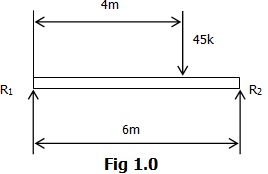
Determine the reaction forces at either end.
Recalculate the reaction forces at either end, taking into account the actual weight of the beam as a UDL. Assume that the mass of the beam is 39Kg/m and g= 9.81 m/s2
Examine two engineering applications of buoyancy?
Discuss briefly the temperature effects on mechanical properties such as a dimensional change, elasto-plastic changes, due to thermal stresses.
Find the acceleration which will be produced in a body having a mass of 60 kg when a force of 150 N acts on this body by using d'Alembert's Principle.
For a domestic hot water system, a copper pipe carries hot water at 70 0c and has an external diameter of 150 mm and is lagged to an overall diameter of 500 mm. If the surface temperature of the lagging is 20 0C determine the rate of heat loss per metre length of pipe if it can be assumed that the inner surface of the lagging is at the hot water temperature. The thermal conductivity of the lagging is 0.09 W/mK.
Task 4.0
4.1
4.11 For the network shown in Fig 2.0, determine Th'evenin's equivalent circuit and the current flowing in the 4 ? resistor. Assume that the battery has negligible internal resistance.
4.12. Use the superposition theorem to find currents Ii , I2 and I3 of Fig 3.0

4.2 Construct a graph of the spectrum for each waveform in Fig 4.0
A = 10 V.
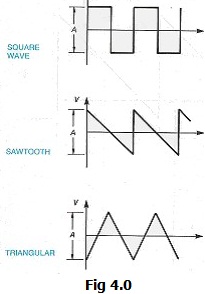
4.3
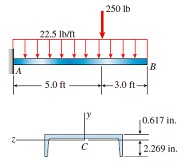
A coil of inductance 74 mH and resistance 28 ohms in series with a 50uF capacitor is connected to a 250 V,50 Hz supply. Calculate :
i. The current flowing ii The voltage across L and C.
ii. Sketch the phasor diagram
A coil of resistance 25 ? and inductance 100 mH is connected series with 0.12 uf capacitor across a 120 V,variable frequency supply. If R is small compare with XL as in radio circuits, Determine :
• the resonant frequency
• the Q - factor at resonance
4.4
Explain the operation of a transformer using the principles of electromagnetic induction.
A 300 kVA transformer has a primary winding resistance of 0.4 ? and a secondary winding resistance of 0.0015 ?. The iron loss is 2 kW and the primary and secondary voltages are 4 kV and 200 V respectively. If the power factor of the load is 0.78, determine the efficiency of the transformer on full load
4.5
Refer to the circuit shown in Fig 6.0
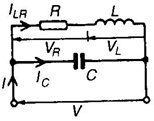
R = 60 ohms, L = 318.4 mH, C= 15 uF, V= 200V, 50 Hz.
Calculate :
• The current in the coil
• The current in the capacitor
• The supply voltage and its phase angle
• The circuit impedance
• Sketch the phasor diagram
Validate the results using simulation packages.
Electrical and Electronic Principles
Assignment - Electrical and Electronic Fundamentals
Learning Outcomes
LO1: Apply an understanding of fundamental electrical quantities to evaluate simple circuits with constant voltages and currents. LO2: Evaluate simple circuits with sinusoidal voltages and currents.
LO3: Describe the basis of semiconductor action, and its application to simple electronic devices.
LO4: Explain the difference between digital and analogue electronics, describing simple applications of each.
Assignment Brief and Guidance
Scenario:
You are presented with the following tasks by the company where you train. The electric network company must carry out these tasks within a specified time limit and most importantly with the highest of standards and proficiency. To prove to the company that you are the right person to work for it you must carry out these tasks with utmost efficiency and professionalism and within the specified time limit. All the tasks involve solving AC and DC networks using the theory and practical experiences you acquired in your modules. All the tasks must be handed in one report which must be clearly and professionally presented.
LO1 Apply an understanding of fundamental electrical quantities to analyse simple Circuits with constant voltages and currents.
Task 1
a. Apply and plot ohms law and determine the slope of an I-V curve (Refer to the lab experiment dc on ohm's law)
b. Apply Kirchhoff's voltage and current laws to analyse the circuit in the experiment (refer to lab experiment dc on Kirchhoff's voltage and current laws).
c. Validate Kirchhoff's laws against the practical results obtained in task1 b
d. Evaluate Thevenin's theorem through simulations and through theory (refer to lab experiment dc on Thevenin theorem and maximum power transfer).
Task 2
A series circuit comprises an inductor of 80 mH, a resistor of 200 ? and a capacitor of 22 uF. If a sinusoidal current of 40mA at 50hz flows in the circuit of fig 1,
a. Determine :
i. Voltage dropped across the resistor
ii. Voltage dropped across the capacitor
iii. Voltage dropped across the inductor
iv. The impedance of the circuit
v. The supply voltage
vi. The current in the circuit
vii. the phase angle
b. Draw phasor diagram for the RLC AC circuit in fig 1 and critically evaluate your results
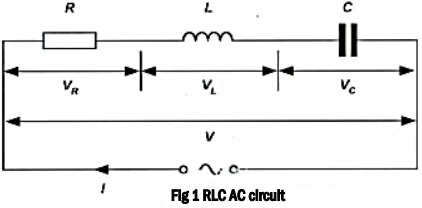
LO3 Describe the basis of semiconductor action, and its application to simple electronic devices
Task 3
a. Demonstrate the action of the following semiconductor devices.
i. Diode
ii. Zener diode
iii. Transistor as switch
b. Describe and evaluate range of discrete semiconductor devices in terms of simple semiconductor theory, suggesting appropriate applications
c. Critically evaluate the performance of Bipolar and FET transistors in terms of simple semiconductor theory, suggesting appropriate applications for each.
LO4 Explain the difference between digital and analogue electronics, describing simple applications of each
Task 4
a. Briefly describe the difference between digital and analogue electronics. Illustrate your answer with examples.
b. Determine practically the Truth table for the following combinational logic gates in Fig 2.
c. Name the logic function in each case.
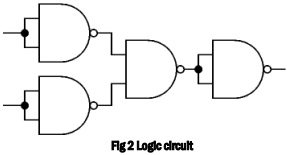
d. Describe the advantages and disadvantages of both analogue and digital electronics.
e. Explain the relative applications of both analogue and digital electronics
f. Critically evaluate the applications of analogue and digital electronics in terms of their relative advantages, explaining with examples where each might be applied.
Electrical Machines
Learning Outcomes
LO1: Assess the constructional features and applications of transformers.
LO2: Analyse the starting methods and applications of three-phase induction motors and synchronous machines. LO3: Investigate the types of generator available in industry by assessing their practical applications.
LO4: Analyse the operating characteristics of electromagnetic transducers and actuators.
Assignment Brief and Guidance
Scenario:
As a trainee you are asked by your company to solve the following tasks related to the construction and design of electrical machines. Throughout the term you have studied all theory about construction and design of different electrical machines. You have to carry out these task with the deadline mentioned in this assignment. Your promotion in the company will depend on how well you solved the tasks and the way you presented and reported the results. Your report must include excellent solutions and professional presentations. All the tasks must be handed in one report within the specified deadlines.
LO1 ASSESS THE CONSTRUCTIONAL FEATURES AND APPLICATIONS OF TRANSFORMERS.
Task 1
a. Describe the main core types of transformers and how they operate
b. What are the main applications of transformers
c. Discuss the main connections of three-phase transformers
d. A transformer has 500 turns in the primary windings and 100 turns in the secondary side. The resistances in the primary and secondary sides are 0.3 ? and 0.1 ? respectively and the reactances are 2.0 ? and 0.1 ? respectively.
Find:
1. The equivalent resistance referred to the primary
2. The equivalent reactances referred to the primary
3. The equivalent impedance referred to the primary
4. The phase angle of the impedance
e. A 200 kVA rated transformer has a full-load copper loss of 1.5 kW and an iron loss of 1 kW.
1. Determine the transformer efficiency
i. At full load and 0.85 power factor.
ii. At half full load and 0.85 power factor
2. Determine the maximum efficiency at power factor 0.89
LO2 ANALYSE THE STARTING METHODS AND APPLICATIONS OF THREE-PHASE INDUCTION MOTORS AND SYNCHRONOUS MACHINES.
Task 2
a. Analyse the operation of induction and synchronous motors and the main applications of these motors.
b. A 400V, 4 Pole, 3 Phase, 50 Hz star connected induction motor has a rotor resistance and reactance/phase = 0.01? and 0.1? respectively and stator resistance and reactance/phase of 0.641? and 1.106 respectively and Xm=26.3. The equivalent circuit is referred to the stator. Determine i) Starting Torque ii) Slip at which maximum torque will occur. iii) Speed at which maximum torque occurs iv) The value of maximum torque v) Full load torque if full load slip is 4%. Assume ratio of stator to rotor turns as 4.
c. Analyse the different methods of starting induction motors and synchronous machines
d. Justify the selection of a motor for a specific industrial application.
e. Critically evaluate the efficiency of a number of available motors and make a recommendation for a specified operational requirement.
LO3 INVESTIGATE THE TYPES OF GENERATOR AVAILABLE IN INDUSTRY BY ASSESSING THEIR PRACTICAL APPLICATIONS.
Task3
a. Explain the types and constructions of generators (direct current, alternating current and excitation)
b. Identify a generator for a specific application, considering their characteristics.
c. A 3Φ, 16 pole, star connected salient pole alternator has 144 slots with 10 conductors per slot. The alternator is run at 375 rpm. The terminal voltage of the generator found to be 2.657 kV. Determine the frequency of the induced emf and the flux per pole
d. Justify the application of a specific type of generator.
e. Assess the efficiency of a number of available generators and make a recommendation for a specified operational requirement.
LO4 ANALYSE THE OPERATING CHARACTERISTICS OF ELECTROMAGNETIC TRANSDUCERS AND ACTUATORS.
Task 4
a. Describe in general terms the parts and operation of a magnetic actuator and transducer
b. Explain fully the different types of transducers ( passive, active and sensors)
c. Explain fully the different types of actuators (solenoid, linear and rotary)
d. The magnetic circuit shown in the figure below has dimensions Ac = Ag= 10 cm2, g =
0.05 cm, lc = 50 cm, and N = 600 turns. Assume the value of the relative permeability, μr = 70,000 for core material. (a) Find the reluctances Rc and Rg. For the condition that the magnetic circuit is operating with Bc = 1.0 T, find (b) the flux and (c) the current i.
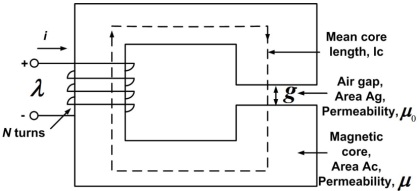
e. Justify the selection of suitable transducers for specific industrial applications
f. Analyse the practical application of transducers and actuators in an industrial situation and make recommendations to improve the operating efficiency of the units in use.